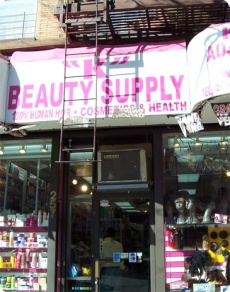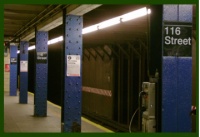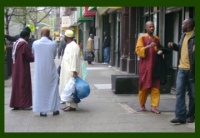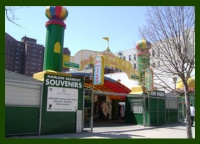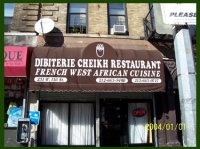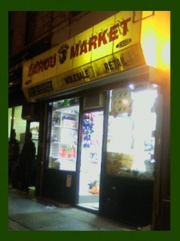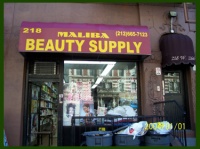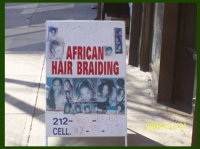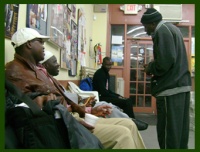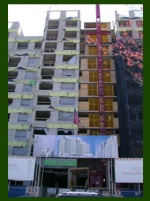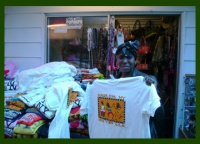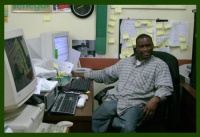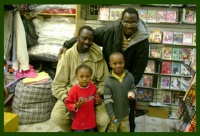Economics
From The Peopling of New York City

| ||||||||
|---|---|---|---|---|---|---|---|---|
Recent History of Little SenegalIn the early 1980s most of Harlem, including the area we focused on along 116th Street, now known as “Little Senegal,” was rampant with drug-related crimes, prostitution and shootings. The area was in such bad shape it was deemed a “no man’s land”. No resident would walk the streets after dark because it was so dangerous. Even yellow taxis wouldn’t drop off passengers in Harlem. The majority of New Yorkers did not want to be anywhere near the community. Those who lived in the area and who were able to improve their economic conditions were quick to move out. Only those who couldn't afford to live anywhere else stayed behind. Housing in the 116th Street neighborhood was in dire condition. Buildings were reminiscent of the old tenements prevalent in 19th and early 20th century New York in areas such as the Five Points. Some were abandoned and others were poorly maintained. The conditions paralleled those documented by Jacob Riis, in his famous work, How The Other Half Lives. Harlem has experienced many ups and downs in its history. Initially it was a rural village but beginning in the late 19th century, it began its transformation to an upper class residential suburb. Real estate boomed in Harlem and so did speculation of property. At this time of prosperity, wealthy Jews dominated Harlem but with an economic bust in the early 1900’s, many land owners, hoping to salvage something, sold their property and moved out. From the late 19th to early 20th century, the great migration of blacks from the South, which increased the black population in New York City, especially in Harlem. They took over the cheap housing left behind from the economic bust, as described by Gilbert Osofky in Harlem: The Making of a Ghetto. As the influx of blacks influenced Jews to move out of Harlem and into the outer boroughs, Harlem became the predominantly black community it is today. By the 1980s, African Immigrants, who were just arriving in New York, found that they could afford the rents in Harlem so they began to settle there. But they had to deal with the violence. Since 116th street was their home, they made the best of what they had. Soon some of these immigrants, primarily the Senegalese, would begin to improve the community and work on “giving it a new touch.” TransformationIn the late 1980’s the Senegalese implemented the first changes to revitalize the 116th community. Senegalese residents opened up numerous small businesses to serve their community. These stores sold African products and services by Africans for Africans in the community.Eventually the initiative taken by the African community was noticed by the city and it too contributed to the rebirth of Harlem by bringing in new western style stores. Transportation problems with yellow taxis were solved when community members started livery cab services. They would pick up and drop off people in the Harlem area. The availability of cheap housing in this poor area also helped to perpetuate the African presence in the community as well. One of the residents we spoke with recalls that apartment superintendents would waive their rent for a couple of months without penalty if residents were unable to pay. He explains that this was due to the fact that no one would rent out the apartments in such a troubled area. Only the African community was willing to take the apartments because they were less expensive than anywhere else and because a lot of other Africans had settled in the area. With more people moving into the area, more businesses opened up and the existing businesses prospered with the influx of new customers. In this manner the community was revitalized both economically and culturally. Niche OccupationsOver time Africans came to dominate a handful of occupations in the 116th street community. These types of businesses became known as their niche occupations. Street vending, hair braiding and taxi driving are all occupations taken over by Africans, especially the Senegalese. Beauty salons, import stores and restaurants are all popular businesses in the community. These types of businesses are numerous along 116th street and draw large numbers of Africans to the community from throughout New York. Street VendingStreet vendors roam the streets of Little Senegal. These vendors first arrived in the 1970s when a small contingent created a “vendor’s market” on 125th Street between Lenox and Eighth Avenues. According to an article published by the New York Times as many as 1,000 vendors frequented the area everyday by the 1980’s. Life as a street vendor however was not easy, in Money Has No Smell: The Africanization of New York City, Paul Stroller documents the difficult lives West African Muslims often lead when they take on these types of street vending occupations. In May 1994, Mayor Rudy Giuliani announced a crackdown on street vendors. The following October, police were ordered to clear out the 125th Street “vendor’s market.” The decision was strongly opposed by vendors. About 150 led a demonstration against the mayor’s orders resulting in 22 arrests. In the next couple of years, the remaining vendors were moved by the city multiple times. In the fall of 1994 they were moved to Lenox Avenue between 116th and 117th Streets. Then in 1998 they were moved again to 116th Street and Fifth Avenue. Finally, a permanent market area was built on 116th Street between Lenox and Fifth Ave, complete with individual vendor stalls. Thus in 1999, with help from the Malcolm Shabazz Development Corporation and the Harlem Business Outreach Center, vendors moved into the newly built “Malcolm Shabazz Harlem Market” and have remained there ever since. The market is very popular and draws many tourists who hope to buy “a piece of Africa.” RestaurantsAfrican restauarats are popular businesses in Little Senegal. Walking along 116th Street you can find a total of eight African restaurants and all have good business regardless of the competition from each other. Restaurants are an important part of the African community because of the busy lives the Senegalese and other African live. When the neighborhood was starting out the main immigrants that settled in the neighborhood were African men. They came to New York alone in search of work to send money back home to their wives. They didn't have anyone to care for them or cook for them. Africans treat cooking and mealtimes with the utmost importance. The men missed home cooked meals after a long day's work, which they couldn't get in New York. The food served here was far from what they ate in Africa. This cuisine nostalgia soon turned into a business venture when an African man opened up a restaurant specializing in African food. This business proved to be very successful because Africans couldn't get this type of food anywhere else. The restaurants continued to be successful even through the changes experienced by the neighborhood. For example, when African women began immigrating to the US to live with their husbands restaurants businesses continued to boom. It could easily be expected that restaurants would have suffered but they didn't. Many of the women came to look for jobs, they came to work and help their husbands. They found work as street vendors or in beauty salons and worked long days just like their husbands. Many would come home from work too tired to cook. They would just go to the restaurant and pick up large platters of food to take home and eat with their family. So the restaurant industry thrived and more restaurants opened up along 116th Street. Today, the African restaurants along 116th street continue to "take people back home," as the owner of Sokhna’s puts it. As they compete with one another these restaurants take quality over anything else. Their competition is in the authenticity of the food. They import all their ingredients fresh from Africa and carefully prepare all their dishes. Quality and taste has made them an important part of the economics of "Little Africa." Import StoresThe businesses that have made 116th Street particularly popular to the African community of New York are the import stores in the area. Around the area there are four import stores, the largest being the Darou Salam Market located at 235W 116th Street. This stores has imports from all over the world including Europe and the Caribbean but its main products come from Africa. These products are very difficult to find in New York and many Africans come from all over the tri-state area to buy their products.The business also sells products that serve as remedies for aches, pains or just general cleansing of the stomach. Alfa for example is used to clean the stomach "this is very good" the worker at the store told me "but it makes you very hungry," he cautioned. The product is even popular with Caucasian people who come to little Africa to buy it. Other popular products of the Darou Salam Market are millet bolle, a product that looks like white pepper corns and sells for $3.00 a bag. This product, I was told is boiled anywhere from 30 minutes to an hour and is served with sour cream. Other popular buys are lalo which is combined with another of their products, chere, to make couscous. Brown millet and onion powder are also popular at the Darou Market. Beauty SupplyBeauty supplies have been popular for more than 20 years with the African people. In the past they were popular for one reason, Africans sought to use the chemicals in the products to try an attempt to make their skin complexion lighter. Africans much like other people of different cultures (ex: Hispanic) believed the lighter your skin was the better off you were. Africans wanted that sense of status. Today beauty supply businesses continue to thrive but for different reasons. The "new generation" of Africans is drawn to beauty products because they want to take care of their skin and take pride in their appearance. These stores have good business all year round but especially during the African religious holidays when people want to look their best. Braiding SalonsBraiding salons have developed a special niche in the African community. These salons provide a large and profitable form of employment for African women. The impact this occupation has had on the status of women has been tremendous. In Africa women are expected to focus all their time on home making and raising children. The husband is the main provider for the family. However, for those women that immigrate to the US, things are very different, they come to the US looking to employment to help their husbands. In the US not only do women find work, in some cases they generate more income than their husbands. Women who work in hair braiding salons especially have an advantage over their husbands in terms of income. Men usually work as vendors selling sunglasses or oils for $5, women working in salons earn $20 for a simple thick braid they make. That’s a big difference, especially when you considered that a single hair design can cost over $100. This occupation has given African women status with their husbands and their community. Many women work in the numerous salons that dot not only 116th street but all of Harlem as well. TaxisIn the film Taxi to Timbuktu the protagonist is Alfa a Malian taxi driver. The life film chronicles the itinerant life of Alfa. This is just an example of the importance of taxi driving in the Senegalese culture. Examples of the popularity of the occupation can also be found on 116th street. A good portion of the African community is employed as taxi drivers. Taxi driving existed in Harlem even before the transformation, however Africans drivers made little money from the job. The majority of clients were Spanish and many would refuse to ride with the driver if he/she did not speak Spanish. This discouraged many Africans from the job.However, as more and more Africans moved into the neighborhood and drivers started to reunite with friends and family from Africa they began to pool their resources and eventually open up their own taxi companies. These companies were very inexpensive and gave African immigrants the opportunity for quick employment. Unlike the taxi companies that already existed which charged a fee to get started and the $70-$90 each week, every week that they worked, African companies had no start up fee and only charged $50 a week every week after that. The price and quick and easy entrance into taxi driving with the new companies were not the only aspects that drove Africans into the business in large masses. The flexibility of the job played a major role as well. Taxi drivers liked the fact that they could chose to work whenever they wanted for however long they wanted and no one would bother them as long as they paid the $50. Many liked it because they could go back to Africa on holidays without worrying about telling their boss or having to be back by a certain time. Continuing TransformationThe transformation of “Little Senegal” continues today. African immigrants revitalized the 116th street area and made the community significantly safer. The transformation, which began in the 1980’s, was monumentous, it gave the area its current cultural richness and flavor. The neighborhood began to thrive so much that it became noticed by the city as well as corporate businesses. This new attention combined with the boom in Manhattan real estate has brought great investments into Harlem and the 116th Street community. It seems that everyone wants a piece of Harlem. Two perfect examples of this “scramble for Harlem” are former President Clinton's leasing of office space along 125th Street and the Kalahari building going up next to the Shabazz Market. If someone looks across 116th Street today, they would notice many areas posted as areas available for rent. The following are two examples of properties available for commercial lease:
Problems and Consequences of TransformationResidentsThe new development in Harlem has sent rent costs on the rise. Due to the high costs of living in the area several Senegalese business people and vendors don’t actually live in the vicinity of 116th Street or even Harlem for that matter. A Senegalese vendor at the Harlem Market named “Sofie,” resides in the Bronx and commutes to Harlem to work everyday. Even before development when rents were low in Harlem, the Bronx still attracted more people with its lower housing now it draws people with greater ease. The rising prices of rent have become an increasingly alarming problem amongst residents. In the 1980s, rent was on average $300 per month, now today it has risen as high as $5,000 to $6,000 a month for the same apartment. This could very well force many members of the community to move out just because they can no longer afford to live in their apartments. Instead of giving tenants extra time to pay rent as mentioned before, some superintendents are now actually requiring two-month rent advances. BusinessesIncreasing rent has affected businesses as well, especially small businesses owned by community members. As seen in the examples of retail space currently offered on 116th Street, the asking prices for rent are restrictively high for most small business entrepreneurs in the area. Existing businesses are struggling to just survive. This is certainly not helped as large western chain businesses settle in on the neighborhood. Most of the existing small businesses simply cannot compete with the new larger ones.A resident who works as a barber on 116th Street says, “Rent is way too high, how can they expect people in this community to pay for it…no one is standing up for us.” He believes some sort of rent control must be implemented. He himself used to own a barber shop of which he had to close due to high rent. Ibrahima Kaaw Sow, is a journalist who works for the American Senegalese Association. He says there has been “no communication with the community about making changes.” He encourages improvement of the area, but makes the point that the city and developers must not forget about existing community members. Kaaw is optimistic however, because he believes there is hope for new ideas and overcoming change. He feels that the community has been strong in determination and adaptation, and will continue to hold those qualities. ConclusionsThe development that is currently being carried out in Harlem is meant to bring greater revenue to the area and have a positive impact on the economy. However, if development isn’t carried out properly and with the culture of “Little Senegal” in consideration, the City will gain economic prosperity at the cost of losing the rich African culture that uniquely exists on 116th street.The African community has done a lot for the revitalization of the neighborhood and their efforts can’t simply be disregarded by out pricing their business from 116th street. “Our African culture and history in Harlem cannot simply be forgotten,” is the plea of Mr. Kaaw Sow. There has to be a way, where both the past and future of Harlem economics can co-exist and further enrich the culture and history of the area. |
